The New Superstars Blazing A Trail Towards The Future Of Fashion
These designers have pushed the needle forward, all while remaining resolute in their conviction to do things their way
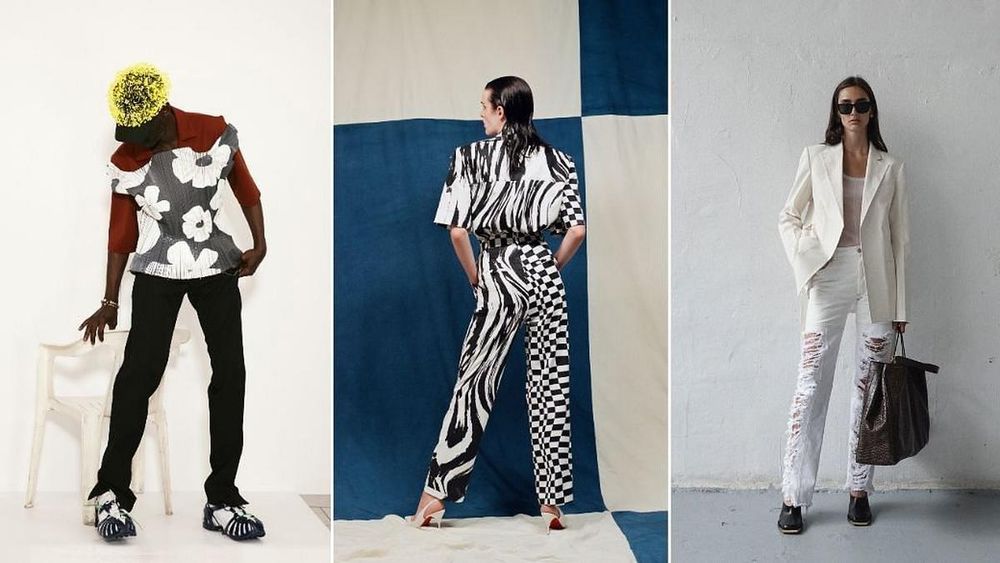
The designers making a name for themselves today are navigating a vastly different landscape than the one their predecessors did. Production cycles have been sped up to dizzying rates, market share is being dominated by a few big conglomerates, and discounting is rampant—as are fast-fashion knock-offs. On top of these, issues such as sustainability and inclusivity can no longer be put on the back burner.
Against this backdrop, a new generation of designers are making waves, not just for the ingenuity of their designs but also for the considerate way they have addressed all the aforementioned issues while building culturally resonant, commercially viable brands. With clarity of vision in both the design and business aspects, the designers we are spotlighting here have pushed the needle forward—from Rushemy Botter and Lisi Herrebrugh’s deconstruction of menswear to create something new infused with Caribbean warmth and elegance, to Christopher John Rogers swimming against the streetwear and sportswear tide to bring couture drama back to American fashion, to Peter Do’s cool, intellectual take on grown-up luxury—all while remaining resolute in their conviction to do things their way.
Rushemy Botter and Lisi Herrebrugh
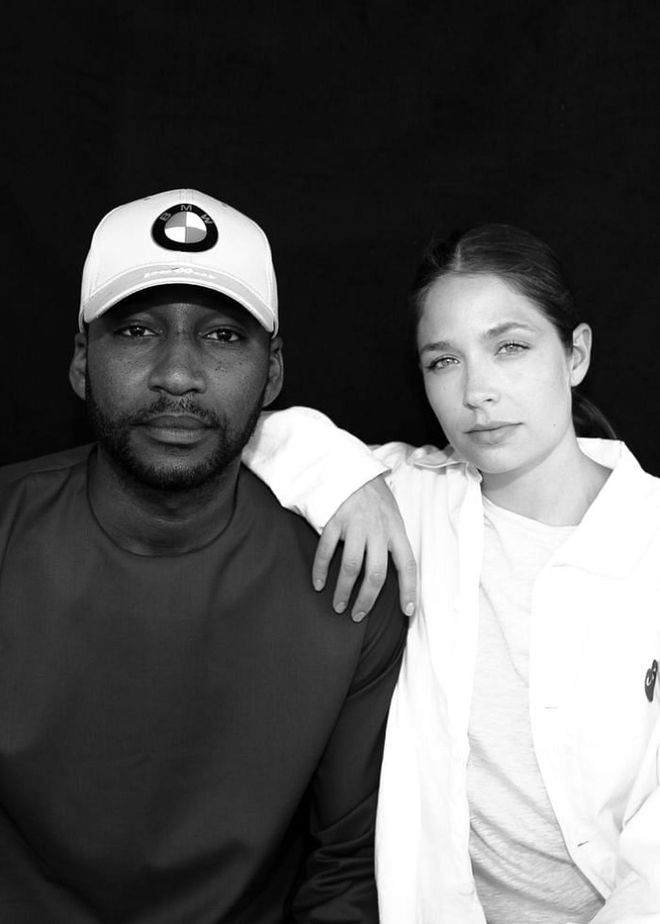
Photo: Courtesy
Rushemy Botter and Lisi Herrebrugh
Rushemy Botter and Lisi Herrebrugh, working under the label Botter, are two of the most exciting names in fashion today. Together, they are bringing a new kind of elegance to menswear—not the haughty European kind, but one more vibrant and warm, heavily informed by their Caribbean roots (he was born on Curaçao Island; she is half-Dominican). Their silhouettes are languid, exuding a certain charming déshabillé—livened up by their often playful use of slogans, print and colour.
Their clothes live at the intersection of streetwear and classical tailoring, with elements both dissected and reconstructed into something new. Herrebrugh describes it as “the allure of the Botter man. Represented in each collection is this fluid, Caribbean aesthetic. The garment needs to be conceptual but comfortable at the same time, bold but elegant.” Botter adds: “There’s always a clash that makes it interesting. We have the Caribbean, a little bit of today—the things you see on the streets—but always a historical reference as well.”
Related article: Gender-Fluid Fashion Finally Enters the Mainstream
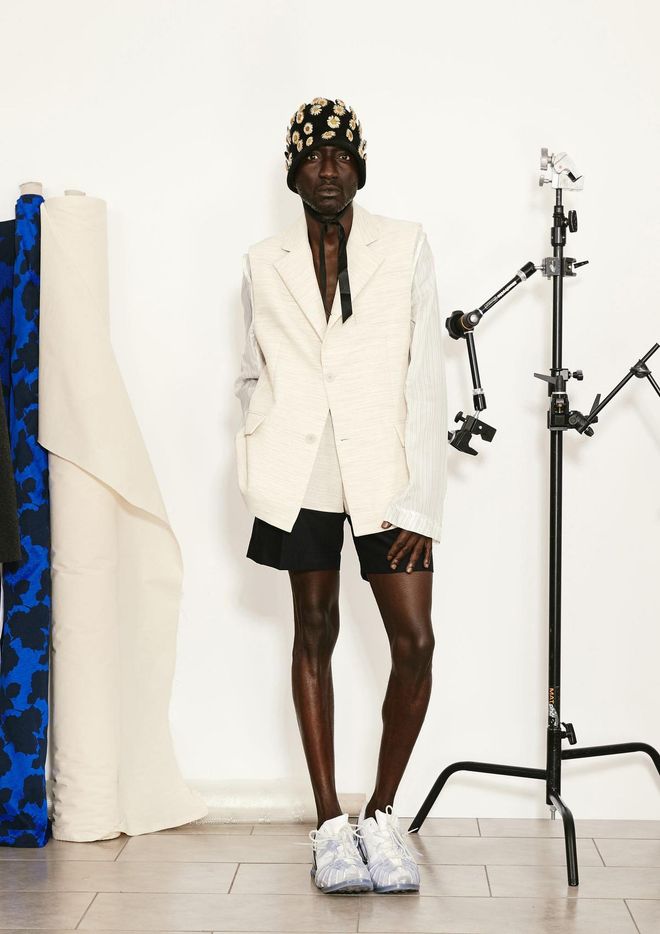
A softer take on the shorts suit at Botter. Photo: Courtesy
Botter Spring/Summer 2021
Since 2019, they have also been excavating the history of one of the oldest couture houses in Paris with their appointment as creative directors of Nina Ricci. “There are people in the atelier who have been there for 30 years—they have all these special techniques. When we go there, it’s like a bomb of inspiration goes off,” says Herrebrugh of their new gig. Botter adds: “It’s an interesting dialogue because we come with solutions and they come with solutions. It’s an inspiring conversation.” That, in turn, has shaped their work at Botter. “What we’ve really taken away are these couture elements that we bring to Botter, but put in a polo shirt or a simple jacket,” says Herrebrugh, reinforcing that clash of the street and the historical.
It’s not just the duo’s aesthetic that sets them apart. Baked into the clothes and the brand ethos are issues that range from the intensely personal to the sociopolitical. Their work touches on both the beauty of the Caribbean islands and the environmental damage they have seen. “The collections are a reflection of how we feel, an expression of what’s happening now in the world,” says Botter. Herrebrugh adds: “We are very emotional designers. Storytelling is the starting point for everything. We cannot talk about the beauty of the island or the nostalgia of our families without also talking about the reality. And the reality is that it has changed—we grew up playing in clear waters and now, you see plastic in the ocean.”
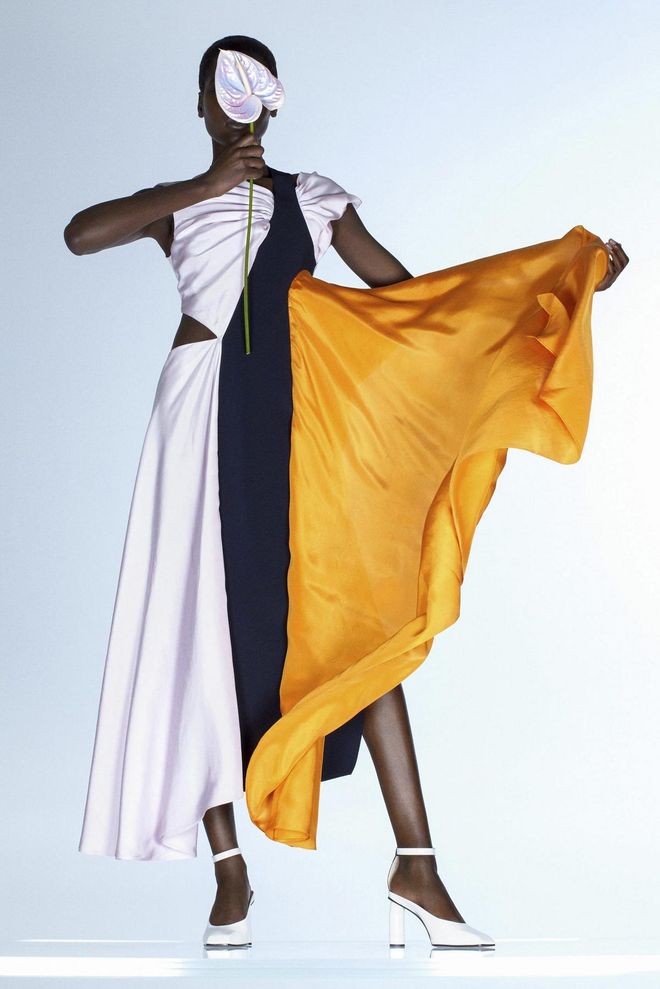
An exploration of cut and colour at Nina Ricci.Photo: Courtesy
Nina Ricci Spring/Summer 2021
As serious as these issues are, the designers take a lighthanded approach, filtering their thoughts through a lens of irreverence. Their ruminations on ocean pollution and depletion, for instance, resulted in plastic-bag tops and fishing-line vests. Far from being flippant, it was a deliberate decision. “It’s important that we don’t force our opinions on people,” says Botter. “We want to start a conversation—that’s the most important thing. It is also who we are; we’re really positive yet realistic. Everything we do is with a twist—it’s not heavy.”
The designers may be keeping the fashion light, but they are putting in heavy-duty work where it counts. For the past year and a half, they have been spearheading the building of a coral farm in the Caribbean where healthy corals will be grown and then transferred into the ocean to restore the coral ecosystems. “We have always talked about environmental issues and with our platform now, we find it important to not only speak, but to do something about it,” says Herrebrugh.
The two see no separation between the causes they champion and the brand that they are building. “For us, it is important to think about more than just garments,” says Herrebrugh. Botter adds: “Building a community, giving back—that’s the really important thing.” Herrebrugh elaborates: “People crave for more than just a silk shirt. Imagine, if you can buy a shirt made from ocean plastic, with the proceeds going to restoring coral reefs, how great is that? You can be part of building back the world the way it’s supposed to be.” With them leading the way, that’s easy to imagine.
Christopher John Rogers
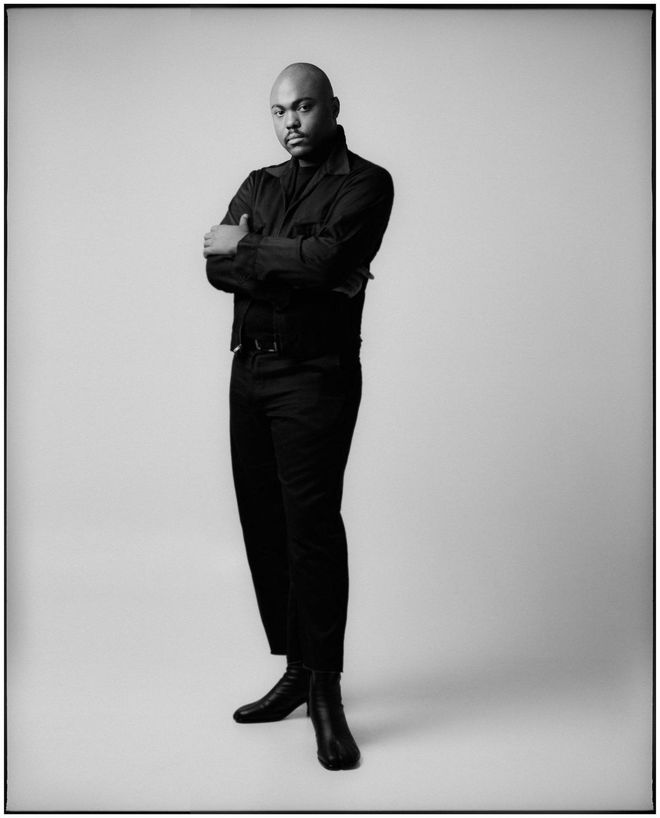
Photo: Courtesy
Christopher John Rogers
Last year might have been a difficult one, but it was also a big year for Christopher John Rogers. He won the American Emerging Designer of the Year award at the 2020 CFDA Fashion Awards, while Zendaya wore one of his bold creations when she made Emmys history as the youngest winner for best lead actress in a drama. The industry validations came on the back of a hot streak that has seen Rogers become the buzziest name on the New York Fashion Week calendar, with his high-octane shows of high-impact clothes.
Fall/winter 2020 was something of a breakthrough; a joyful ode to ballroom culture and Eighties excess—it crystallised what have quickly become Rogers’s signatures, namely his mastery of a statement silhouette and an exuberant palette. His work may be high on drama, but it doesn’t sacrifice wearability for theatricality. Underneath the hot flashes of colour and the exaggerated shapes are very real women—something even more evident when he shot his spring/summer 2021 collection on a diverse range of women. “I want our clothes to become tools for people to use to express themselves in ways that words can’t. I want them to feel confident and I want them to feel comfortable. There has been a renewed interest in high glamour that’s also pragmatic—something we specialise in,” says Rogers of what drives his work.
Related article: How Marine Serre, Gucci, Prada, And More Are Fashioning A Sustainable Future
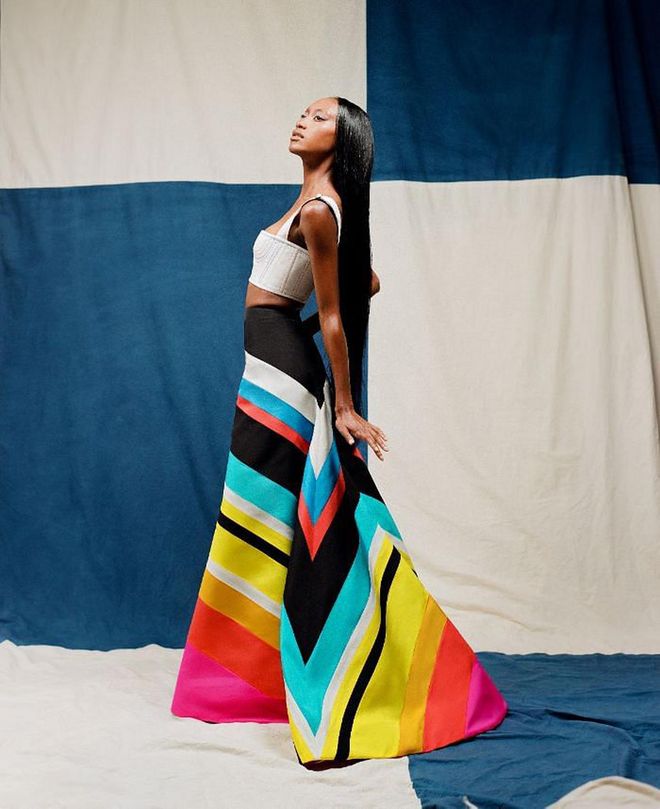
A cropped top offsetting a statement ball skirt. Photo: Courtesy
Christopher John Rogers Spring 2021
This approach has clearly been resonating at retail, with pieces often selling out even without his many celebrity endorsements. Net-a-Porter was one of the earliest to champion his work and the retailer’s fashion director Kay Barron says: “It takes a brave and forward-thinking young designer to enter the industry making statement, couture-like clothing. Christopher made waves immediately by taking risks that paid off and he has been daring in the craftsmanship, silhouettes and volume of his designs. It’s easy wearability, but strong visual impact.”
With most of the industry hitting pause for the better part of last year, Rogers has had the opportunity to refine what he wants his brand to be. He says: “Having had the time to think about everything from colours, fabrics and hemlines to interlinings, button shapes, shoulder widths and interior constructions really elevated our offering. Quite often in fashion, there isn’t a ton of time to ruminate on your work, so it was refreshing to be able to do that—take time to work on a body of work that feels completely reflective of myself as a designer.”

A boxy suit in highlighter green. Photo: Courtesy
Christopher John Rogers Spring 2021
What he does not want is scaling too quickly; growth for growth’s sake. “We’re a small team of four, and it has been great to see how much we can do and how focused we can be by keeping it small. Strategic and intentional growth is something we’re aiming for, but at a sustainable pace. So many young brands burn out because they try to be everything to everyone, and we’re more focused on specificity,” he says. With this kind of eye for design and head for business, Rogers is one of those who will be burning bright.
Peter Do

Photo: Courtesy of LVMH Prize
Peter Do
Save for a handful of exceptions, American fashion is not often associated with high-end luxury ready-to-wear of the sort that fashion people like to call wardrobe heroes. Peter Do is changing that. Though growing in profile and popularity with each season, for now, he remains somewhat of an insider secret and that is entirely by choice. The designer doesn’t do runway shows, advertising or influencer seeding. While presentations during the higher-profile women’s fashion weeks in March and September would have caused more of a splash, Do opts to present during pre-collection weeks—a move that isn’t so much contrarian as it is doubly smart: Buyers still have their full budgets to work with and his factories would get a head start on his production.
In the vein of the great Martin Margiela, he doesn’t even do photographs and gives very little interviews—letting his work speak for itself. And his work, though on the quieter side, speaks volumes. Having honed his craft under Phoebe Philo at Céline, Do shares Philo’s appreciation for beautiful fabrics, inventive but fuss-free construction, and a sense of elegance that is a little off-kilter.
Related article: Sustainable Fashion: New Designers Are Rethinking The Way They Create

The perfect balance of structure and slouch. Photo: Courtesy
Peter Do
Instead of a relentless quest for newness for newness’s sake, Do has built a healthy business by revisiting his signatures and reiterating the things that work. His bestsellers are made permanent on his e-commerce store instead of being shuffled off after a season. These include his ultra-cool tailoring, often subverted with subtle innovations and manipulations such as his signature convertible and adjustable features. His strength lies in the new ways he plays with the masculine-feminine trope, but his femme is decidedly womanly, not girlish. Net-a-Porter’s Barron says: “Peter’s designs are so unique, and his knowledge of fabrics and craftsmanship, so refined—the quality of his tailoring is second to none. There is a real confidence and sophistication to his vision and execution. He knows what women want to wear before they do. From his sharp tailoring to his architectural knits, his clothes are super easy to wear with a unique sense of colour—they are pieces so timeless that they’ll become future classics.”

Elegantly off-kilter construction and layering. Photo: Courtesy
Peter Do
Even as his star rises, he keeps his list of retail partners relatively small—only 40 stockists worldwide—which both heightens the aura of exclusivity around his clothes as well as allows him to continue manufacturing locally in New York’s endangered garment district. In a conversation with Chantal Fernandez for the Business of Fashion, Do said: “I don’t look at the big guns like LVMH and Kering, and compare ourselves to them. I don’t want to be in every department store—that’s not the goal. My dream is still to be free to create work that we love.” Judging by his critical raves and commercial hits, plenty of women (and more than a few men) are loving it too.